This article is the third in a series covering the various types of heraldic flags found in the Middle Ages, providing enough of an overview to their use to inspire the reader to design and paint their own. Each article will describe the distinguishing features of the flag type, including their typical use in period, using examples from period art where available. At the end of the article, I will guide the reader through the process of designing a new flag using armory appropriate both to the SCA and history. This article covers an incredibly versatile heraldic flag: The pennon.

A pennon is a triangular or swallow-tailed heraldic flag that originally displayed the owner’s arms, but found a new purpose when badges became popular in the early 15th century.
Personal pennons appeared in two different sizes. The smaller pennon, or pennoncelle, was approximately 12-18 inches long from hoist to fly, while the larger pennon, or lance-pennon, was about 3 feet long. According to Gayre’s Heraldic Standards*, lance-pennons were used by bachelor knights as a mark of their station (as opposed to banners, which were borne by knights banneret), while pennoncelles were used by those of any rank. On the battlefield, these pennons functioned as a location marker for the individual owner as well as a rallying point for those who served under him.
Larger pennons, precursors to the more elaborate standards and owned by high nobles, displayed the same armory as the noble’s banner. However, the triangular shape of the pennon marked it as distinct from the banner. The banner indicated the individual noble’s place on the battlefield, while the large pennon showed the location and direction of the soldiery.
* Gayre of Gayre and Nigg, Robert. Heraldic Standards and Other Ensigns, Their Development and History. Oliver and Boyd, Edinburgh, 1959
Shapes
Pennons come in three distinct shapes: Pointed pennons, swallow-tailed pennons, and pavons.

Swallow-tailed pennon, from Arthurian Romances, Beinecke MS 229
Pavon, from the Navarre Picture Bible, Amiens – BM – ms._0108
Pointed Pennons
A pointed pennon, also known as a triangular pennon (a singularly useless categorization given the existence of the pavon, below), is shaped as an isosceles triangle, and is the precursor of the modern pennant. This shape appears to be considered the default shape for pennons, and is generally assumed when no other term is provided.
Lance-pennons in this style tend to be between three and four times as long as they are tall, while pennoncelles are generally much longer relative to their height.
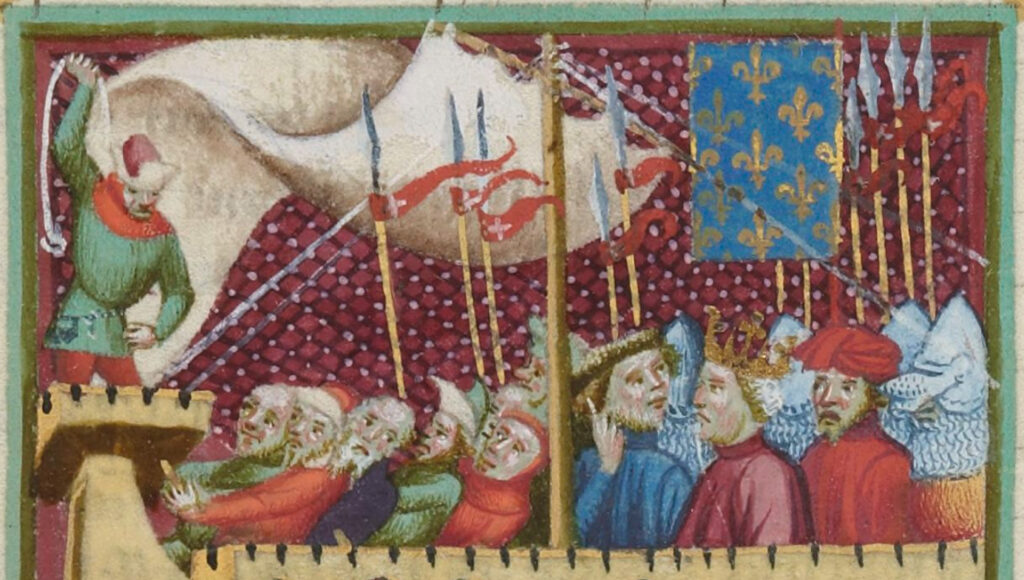
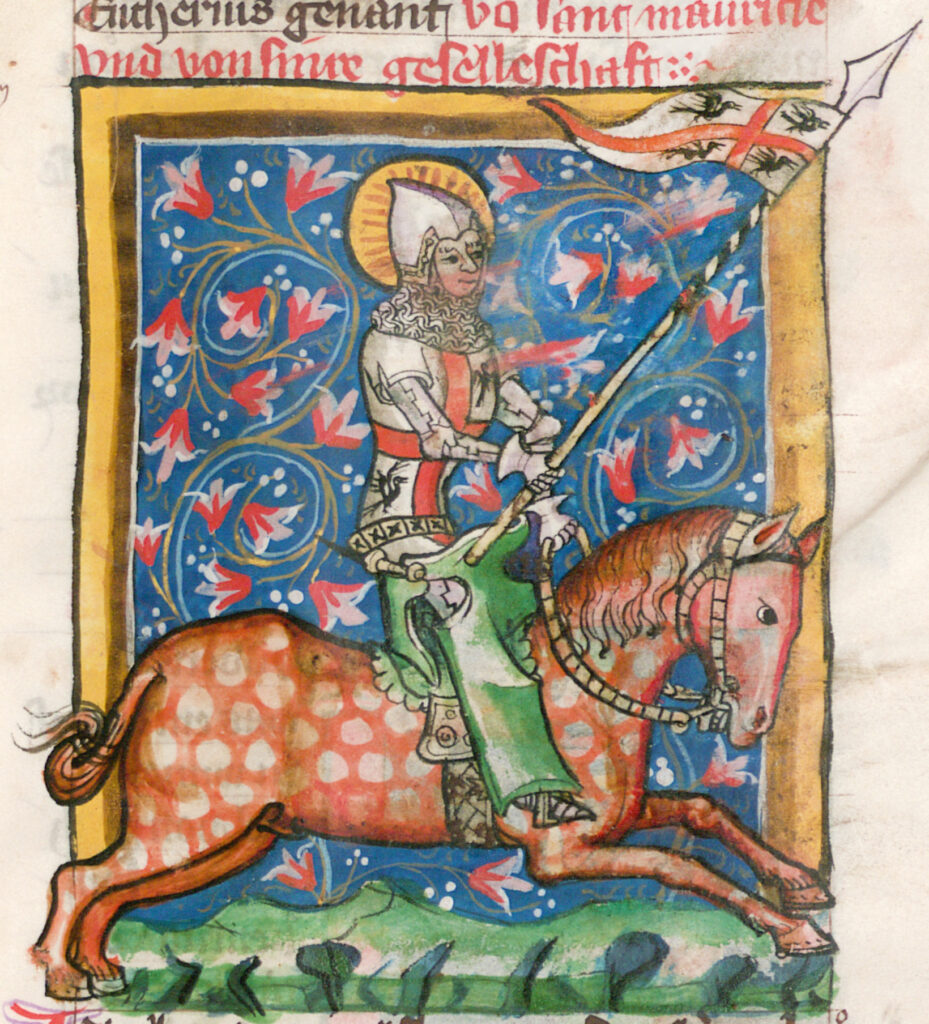
Swallow-Tailed Pennons
A swallow-tailed pennon is similar in form to a pointed pennon, but with the fly split into two points.

Depictions of swallow-tailed pennons vary, with the split ranging from a thin slit to a wide cut-out, and running from less than a quarter to more than half the length of the fly.


Pavons
A pavon is a pennon shaped like a right triangle. It appears to have been exclusively used on horseback.

Perhaps the most famous pavon appears in the portrait of Geoffrey Luttrell.

The pavons above are all pennoncels, identifiable because they are almost twice as tall as they are wide; lance-pennons in the pavon style tended to be equally tall and wide, as seen below.
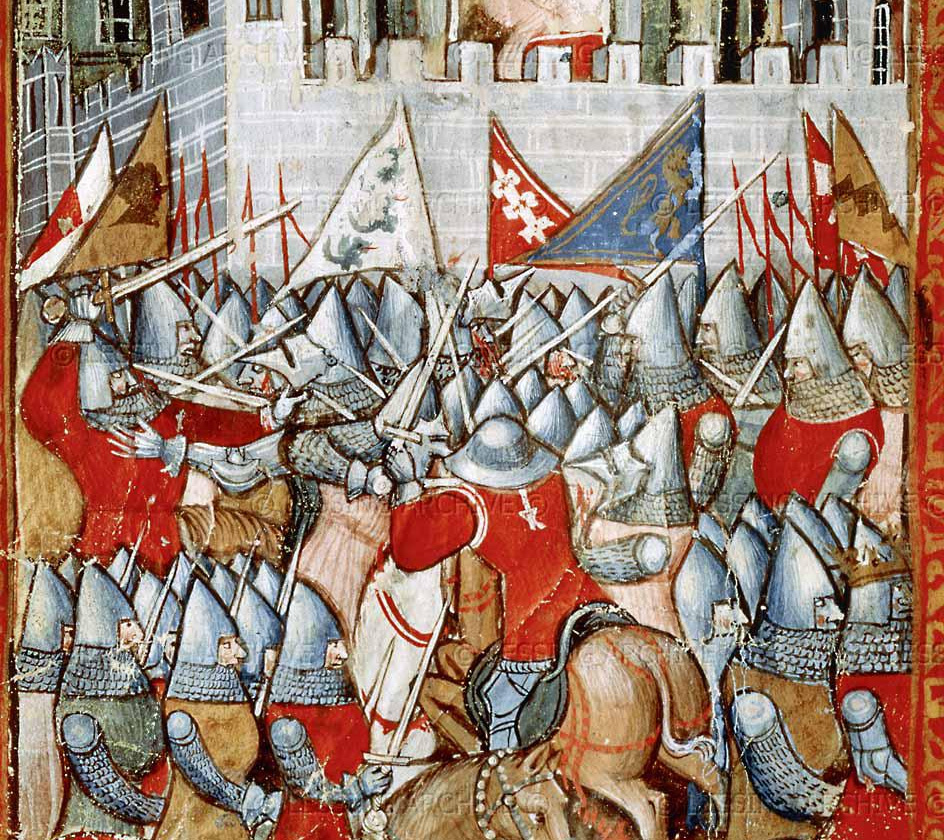
The shape of the pavon made it difficult to lay out heraldry in a recognizable manner. In the example from the Luttrell Psalter, for example, the bend would normally follow the same angle as the upper edge of the fly; in order to give the martlets enough space, the design was reversed with the bend becoming a bend sinister. Because of this, the pavon did not last in this form beyond the 14th century.
Larger Pennons and Early Standards
The underlying principle of sumptuary laws, as succinctly expressed by Zero Mostel, is “When you’ve got it, flaunt it!” As bachelor knights served under bannerets, bannerets in turn served under Nobility and Royalty, who required a bigger and more impressive flag than a banner to focus their forces. The solution? Larger pennons!

In King Rene d’Anjou’s Tournament Book, two companies enter the tournament, captained by the Dukes of Brittany and Bourbon. In the scene below, each side of the tournament takes up residence in a hotel with their banners hanging from every window. King Rene notes:
Les chiefs dudit Tournoy font pareillement devant leurs hostels comme les autres seigneurs et barons: et n’y a différance nulle, fors que aux fenestres de leursdits hostels mettent leurs pannons desployez avecques lesdites bannières.
(The captains of the tourney should do the same as the other lords and barons in front of their inns: there is no difference, except that at the windows of their inns they should display their pennons with their banners.)

The pennons in this manuscript are just as tall as their corresponding banners, and much longer.

At this larger size, and especially when paired with a banner (which marks the location of the individual noble), these larger pennons function solely as rallying point for the noble’s forces. The larger pennon thus becomes functionally identical to a standard.
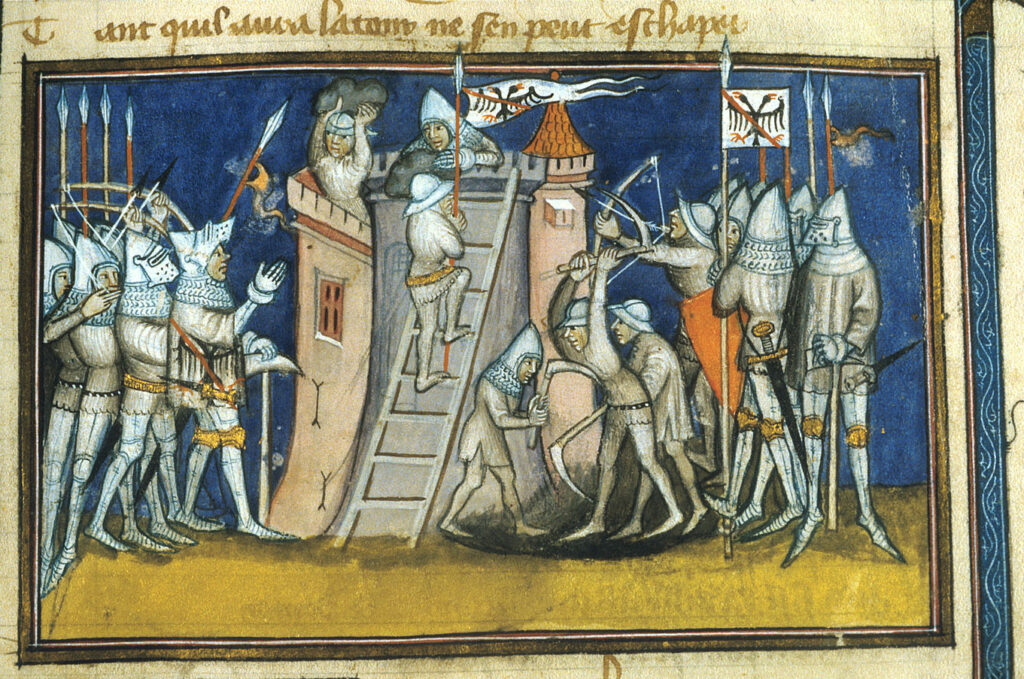
Indeed, as larger pennons grew in size they became indistinguishable from early standards (that is, standards prior to the rise in popularity of badges) in both form and function.
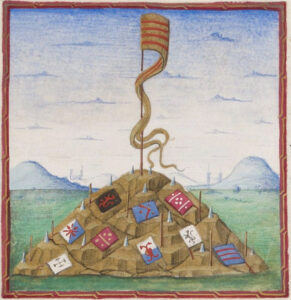

Badge-Pennons
With the rise in popularity of badges in the 15th century, pennons became the primary flag for their display. When used on the battlefield, badge-pennons served as rallying points for smaller fighting units, such as the crossbowmen in the image below.

Badges also appear on larger pennons, as in this example from the Chronicles of Jean Froissart, where the English fight under a pennon emblazoned with the Cross of Saint George.

By the Tudor period, the badges of major nobility and royalty appear on pennons in rolls of arms such as Prince Arthur’s Book (1480), artwork of which was reproduced by Gayre below. Note the swallowtails peeking out of the bottom right edge.

Not seen in Gayre’s reproduction are the supporters holding the pennons: A white hart for Richard II, a white lion for the Duke of York, and a golden lion for Edward III. These same badges and livery repeat on standards in manuscripts of the same period, along with their respective supporters.
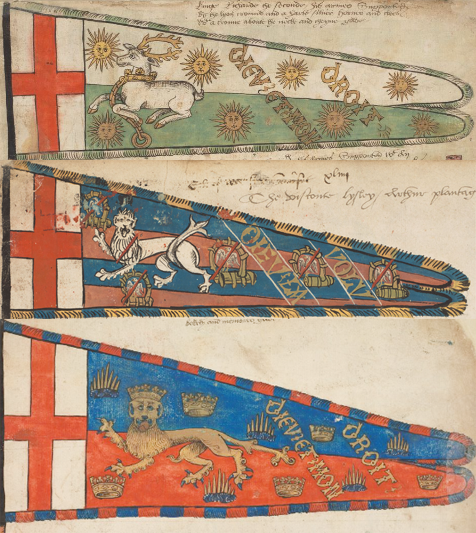
Badge-pennons are thus particularly useful as a medium to display badges that show affiliation or allegiance, rather than ownership. I will go into more detail about this in a future article.
Orientation: Upright vs. At Charge
Some pointed pennons, especially pennoncelles, are oriented with the hoist to chief, so that the armory is properly displayed “at charge,” or with the spear or lance horizontal. We see this orientation in the funerary brass of John d’Aubernon, and in a larger pennon from the Grandes Chroniques de France.
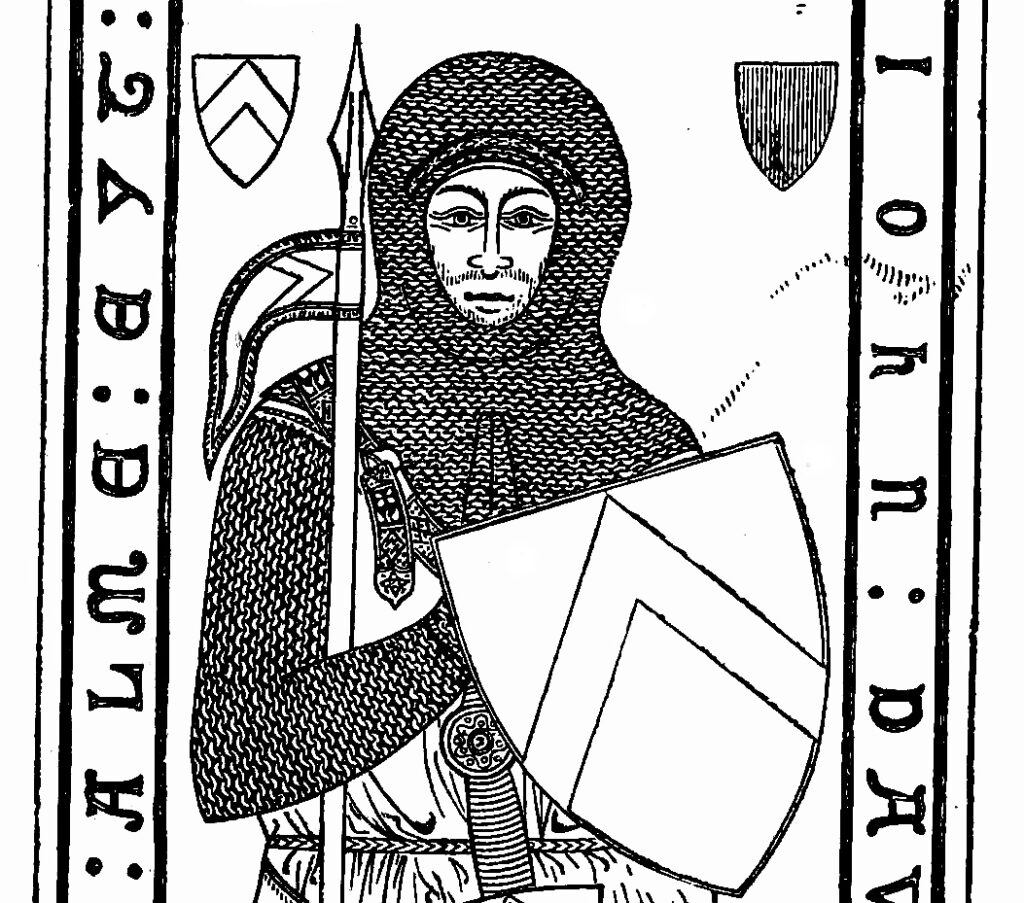
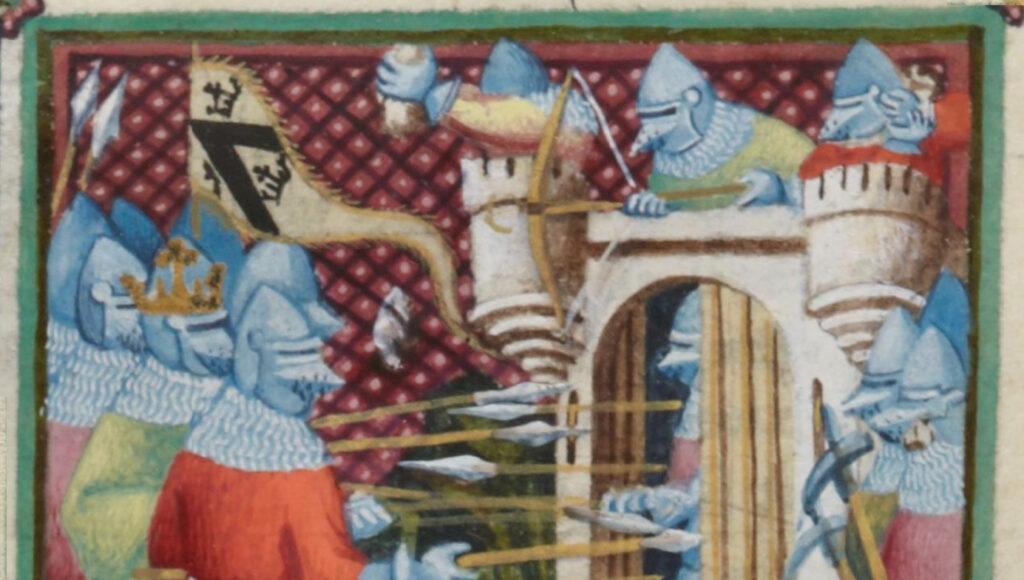
However, most lance-pennons mirror the orientation of banners, with the hoist to dexter. This is unsurprising, given that there is a ceremony where a bachelor knight is promoted to a knight-banneret by cutting off the tails of the pennon to transform it into a banner (cf. banners).
Pennons as Decoration and Effect
The appeal of pennons, especially badge-pennons, stems largely from their ability to create movement and color in a smaller space. Pennons used to adorn small finials on the corners of pavilions or wagons give panache and pageantry without requiring long poles or lots of silk. However, nothing compares to the effect of a collection of pennons in similar livery all fluttering in a single area.
The image below is taken from Miller Arthur’s depiction of a procession in Brussels in 1615. Though the image is just post-period, you can see that the swallow-tailed pennons are exactly the same shape and size we’ve seen throughout this article. But the collection of multiple flags in the black, white, and red of the group’s livery, each flying from its own spear, provides a beautiful example of the cumulative effect of pennons.

This effect is particularly relevant to our use in the SCA. While the troop of horsemen with pennons are not the most impressive in the Omnegang procession, their use of pennons as a pageantry tool is much easier to emulate in our group than the multi-story pageant wagons elsewhere in the scene. From court processions to camp perimeters, pennons enhance medieval ambience using relatively little fabric.
How do I design my own pennon?
When deciding to make a new pennon, consider:
- Where will this pennon fly? Examples: Pavilion, camp gate, armored combat spear, list field ropes
- How large do I want this pennon to be? If attached to a weapon, consider a pennoncelle and stick with 18″
- What design do I want to put on this pennon? And relatedly…
- What orientation makes the most sense for this design?
Shape
Pennons, as previously stated, stick with a few basic shapes: pointed, swallow-tailed (narrow and wide forks), and pavon.

For lance-pennons, the ratio of 3:1 for pointed and swallow-tailed pennons and 1:1 for pavons works well, while pennoncelles have ratios closer to 8:1 for pointed and swallow-tailed and 1:2 for pavons.
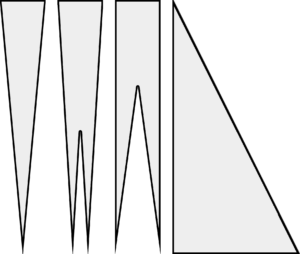
Some pennon shapes work better for designs than others. My device, for example, has a field division that lines up well with some swallow-tailed pennons, in both orientations.
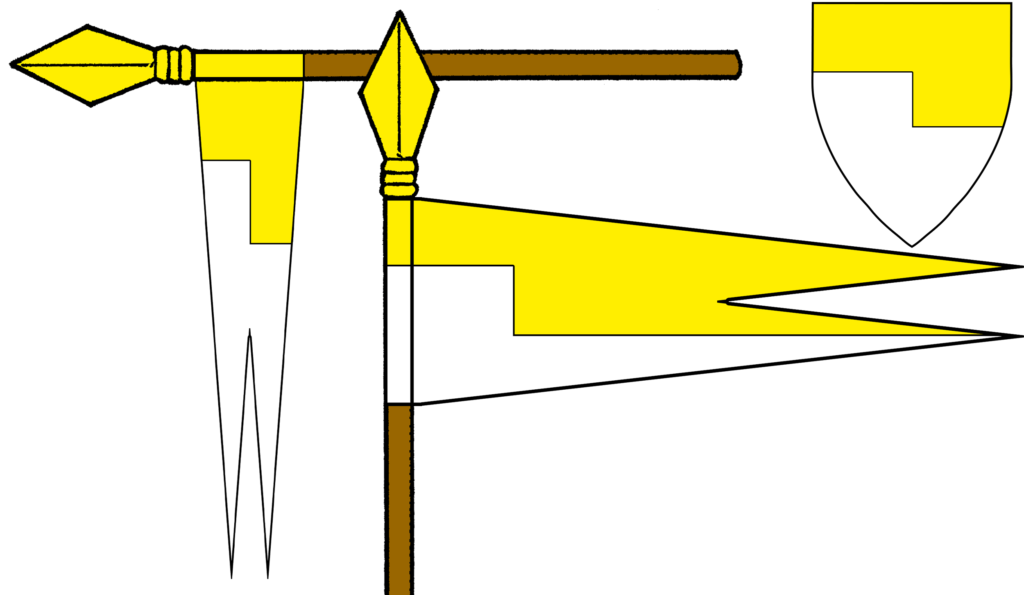
Generally, pennons on functional weaponry (excluding pavons) should be rendered “at-charge,” or with the hoist to chief. However, while many designs might work well in this layout, some might look better when displayed upright. See, for example, a pointed pennon with the ensign of An Tir, Checky Or and argent, a tierce sable.

If a charge is generally oriented palewise, a pennon at-charge is a good option. If the charge is generally oriented fesswise, a pennon upright will tend to look better. See the badges for the Chatelaine and Seneschal, respectively.
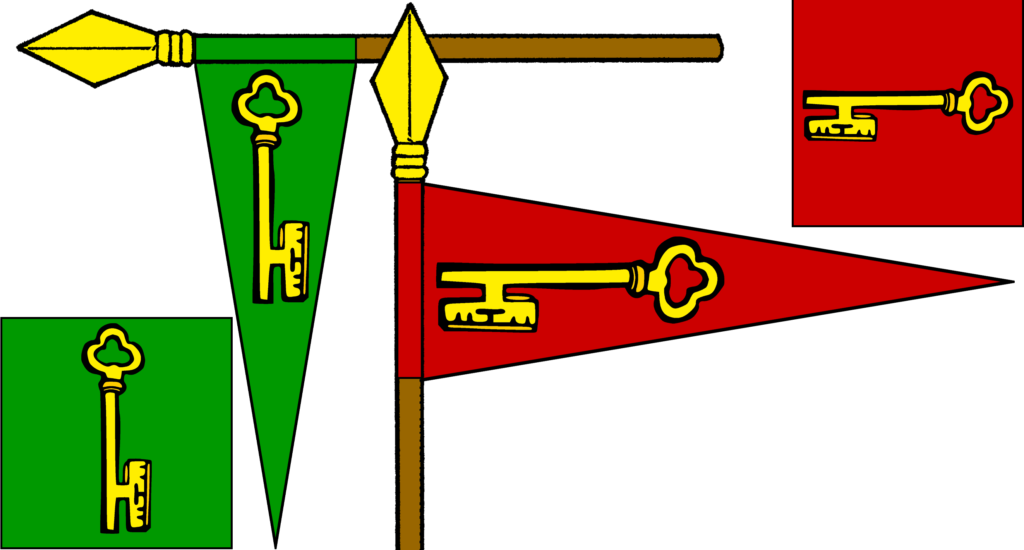
Should you decide to design a pavon, take care to lay out the device carefully, in a way that will fill the available space while remaining recognizable. Below are pairs of pavons in the arms of An Tir and Caid, as full-size pennons and pennoncelles. For An Tir, the limbs splay out into the three corners of the pavon while maintaining the posture of the lion. For Caid, the crescents shift into the corners.


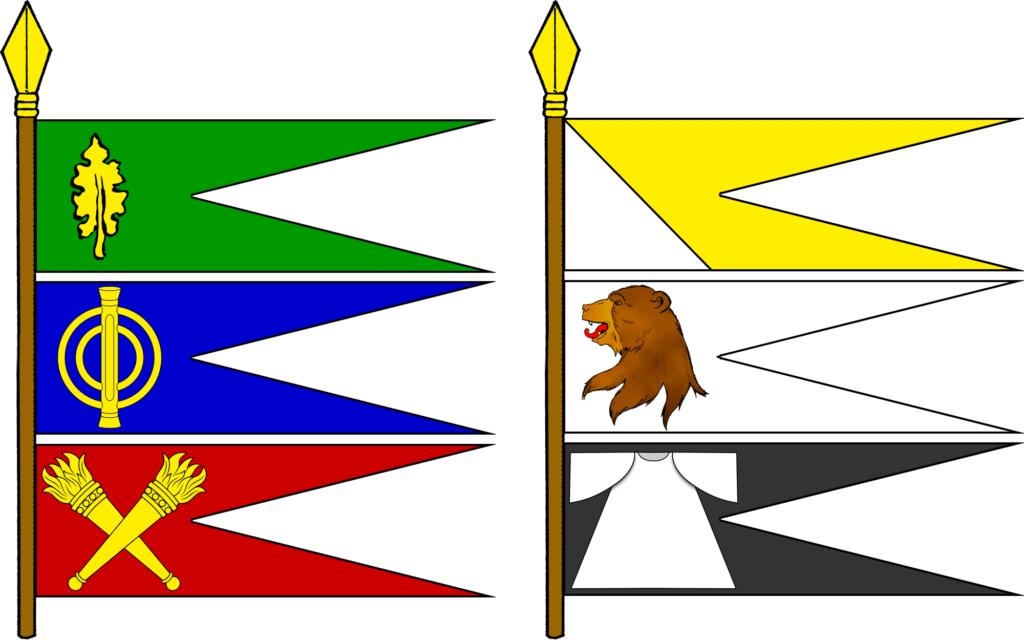

So the next time you want to make a heraldic flag, especially one that shows your allegiance and affiliation, try pennons!
What other kinds of heraldic flags are there?
For more information about heraldic flags, please see the options below:
Standard – A large, tapering flag used to display the badges of its owner, a rallying point for armies.
Banner – A square or tall rectangular flag, used to display arms
Gonfalon – A processional flag hung from a horizontal pole, can display arms, full achievement with awards, artistic motifs unrelated to heraldry